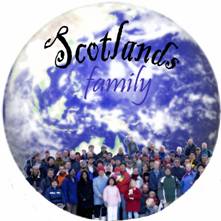|
.
AVAILABLE SCOTTISH
GENEALOGY RESOURCES
Births
and baptisms data
Marriages data
Censuses
Directories & Lists
Poorhouses
Occupations
Diseases & Medical terms
DNA Testing
Map
of Scotland
County map
Parish maps
Gazetteer
Books
& Film
Statistical Accounts of Scotland
Scots Dictionary
Research
help
Links
Top UK Betting Sites
 |
Stories on
Searching for Scottish Ancestors ...........
Visiting Your Gravestone
Oor first breath is the
beginning o' daith
A day out to visit your gravestone sounds macabre today, yet three or four
hundred years ago your Scots family would have taken pride in showing off
to friends their personal or family stone in the kirkyard. Just as it was
a sign of sufficient wealth and importance to lay claim to reserved pews
in the local church, so it was you could pay to have your stone placed in
the kirkyard itself while you were still hale and hearty, and could afford
it. It was satisfying to know it was waiting for you. Memento Mori was
often carved on these stones -it means "remember you will die".
Carved symbols were more important than names in the 17th and early 18th
century headstones. The skull, crossbones and hourglass were a reminder of
the mortality of man, whereas an angel blowing a trumpet, or a winged head
promised ascension to heaven, at least for the chosen elect. Symbols of a
craft might be carved - a mason's trowel, a smith's hammer, a gardener's
pruning hook, and sometimes but not always initials and a date. To the
North side of every church was an area devoid of stones, reserved for the
poor, the outcast and strangers. Even from the grave the family of means
could assert their separateness from the anonymous mass.
But upright headstones for a grave, or a future grave, was a relatively
recent innovation. Formerly the stones were laid over the grave, and these
slabs or thrughstanes were there to cover the corpse until the day of
Resurrection. In parts of the north-western Highlands up to the 1700's,
the slabs had a more prosaic purpose. The rocky terrain and thin soil
often only allowed for the digging of shallow graves. The slabs over the
graves then offered some protection from scavenging wolves. Even so, this
problem became so great in some areas that the crofters took to rowing
their dead over to off-shore islands to bury their relatives in wolf-free
terrain.
Scots have no particular fear or fascination about death, and yet it has
played a huge role in the making or unmaking of so many of our historical
figures. Who does not know the story of William Wallace hung, drawn and
quartered for his belief in freedom. Then there was the beheading of Mary,
Queen of Scots on the orders of Queen Elizabeth, the torturing to death of
Covenanters in the Killing Times, the hanging of the body-snatchers Burke
and Hare.
The poet Robert Burns describes the gory scene in Kirk Alloway graveyard
through the eyes of Tam o'Shanter:
A murderer's banes in gibbet airns;
Twa span-lang, wee unchristen'd bairns;
A thief, new-cutted frae a rape
Wi' his last gasp his gab did gape.
A garter, that a babe had strangled;
A knife, a father's throat had mangled..
And if this tale of death has got you thinking about your own mortality -
Memento Mori - and what might grace your gravestone one day, spare a
thought for an Edinburgh resident whose stone reads:
Erected to the memory of John
Macfarlane
Drown'd in the Water of Leith
By a few affectionate friends.
.....................................................................................................................................................
This
article by Dr Brian Thomson of
Scot Roots was first published on the web
in the
Scottish
Radiance magazine in September 2000.
If you would like
a story from your family history published here please send to
stories@scotlandsfamily.com for consideration . From 200
words to 500 words max please.
|
|

ScotlandsFamily.com (c) 2006 |
If you have found
the resources in Scotlands Family helpful, you may wish to
Add us to your favourites, or link to us from your website.
And feel free to
if you have discovered other useful Scottish
genealogy resources that could usefully be highlighted within
ScotlandsFamily.com
Good luck with your Scottish ancestor searching !
|
|


